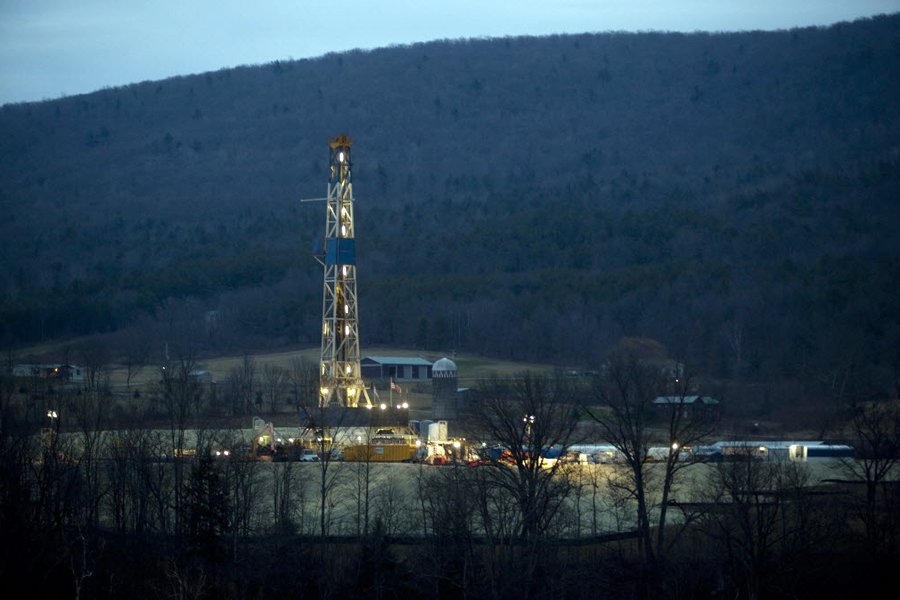Fracking waste water contaminated Pennsylvania streambeds, study finds
Loading...
Despite being treated, waste water from fracking and other forms of gas and oil extraction can leave elevated levels of contaminants in streambeds at the point they are discharged and well downstream, according to a study published Wednesday.
Among the potentially harmful effects of the waste-water discharges, the study found, is the creation of radioactive hot spots from naturally occurring radium that settles out of the treated water and into streambed sediments.
The study, which tracked contaminants once they become part of a stream's flow, examined the outflow from a waste water-treatment facility on Blacklick Creek in western Pennsylvania and its effects on the creek's water and bottom sediments.
The facility is one of three in the region involved in a settlement with the US Environmental Protection Agency (EPA) in May that resulted in a $83,000 penalty for the owner, Fluid Recovery Services, LLC, for violating provisions of its water-treatment discharge permit.
Researchers from the University of Pittsburgh's Graduate School of Public Health found high levels of barium, benzene, chlorides, strontium, and other contaminants at the end of the outflow pipe in excess of state and federal water-quality standards.
They presented their results at an EPA workshop on the fate and transport of waste water from fracking in March 2011 and formally published their results last March in the journal Environmental Science and Technology.
Four months after the EPA workshop, Pennsylvania's Department of Environmental Protection collected sediment samples from inside the discharge pipe at the site and found radium-226 levels some 44 times higher than drinking-water standards allow. Several tens of yards downstream, levels were 66 times higher than standards allow. Radium-226 has a half-life of 1,600 years.
Fracking, or hydraulic fracturing, involves pumping liquids at high pressure into underground rock formations to break up the rock and get at oil or gas deposits that otherwise would be uneconomical to exploit.
The northeastern quadrant of the United States has become a hotbed of production using this technique, with the activity centered largely on the Marcellus Shale deposits buried beneath New York, Pennsylvania, Ohio, and West Virginia.
The extraction industry in Pennsylvania reused some 70 percent of its waste water in 2011, notes the new study, conducted by Nathaniel Warner, a postdoctoral fellow at Dartmouth University, Duke University geochemist Avner Vengosh, and two other colleagues.
They note, however, that depending on the contents of the waste water – brines that flow back up from depth, or drilling fluids, for example – between 8 and 20 percent of the waste is delivered to treatment plants, with the outflow entering local streams. The remainder of the waste is disposed of using other approaches, such as deep-well injection.
The question the team was trying to help address: "What's the larger, overall impact of all this new shale-gas development," Dr. Warner says. "We looked at interactions with shallow ground water and didn't find major impacts. But what happens with surface-water disposal?"
They started about 1,000 feet upstream of the outflow pipe and took repeated water and creek-bottom sediment samples for another mile below the outflow point. The upstream samples and soil samples taken away from the creek helped establish the background levels of the compounds they team was interested in examining. The team also took water samples from three major rivers in the region to help establish background levels.
The team gathered the complete set of samples along Blacklick Creek five times between August 2010 and November 2012. They used chemical and isotopic analysis to pinpoint the Marcellus Shale formation as the source of a large proportion of the wastes released in 2010 and 2011. In 2011, Pennsylvania environmental officials asked that treatment plants stop accepting waste water from operations in the Marcellus formation.
Overall, the team found that over the study period, the plant had removed more than 90 percent of the barium and radium in the original wastewater.
Still, chloride concentrations as far as a mile downstream were from two to 20 times higher than anything the team recorded upstream or in any other stream it sampled. Of particular concern were elevated levels downstream of bromine, which has the potential to combine with chlorine in drinking-water treatment plants to form compounds that public-health specialists have linked to certain cancers.
As for the radium, the researchers measured levels of radium-226 at the outflow some 200 times higher that levels found upstream or in soils around the stream. That level exceeds the threshold at which radioactive-waste-disposal regulations kick in, the scientists noted.
Based on the relative abundance of radium-226 and its far-shorter-lived relative radium-228, the team says it was able to identify fracking wastes as the main source for the radium it detected. That coincided with previous studies noting that more than half the waste the facility took in between 2010 and 2011 came from the Marcellus formation.
The team also offered an explanation for the radioactive hot spot it and Pennsylvania environmental officials found in the creek. Dissolved radium attaches to sediments grains more readily as water shifts from salty to fresh, the researchers note. That's precisely what happens at the end of the outflow pipe, as the briny waste mixes with fresh water from upstream. Thus, even though the treatment plant significantly reduced the amount of radium entering the stream, chemistry took over to concentrate the radium near the outflow point.
Given the 1,600-year half life of radium-226, the researchers suggest more work needs to be done to gauge the effect such hot spots can have on aquatic plants and animals in and around them, since freshwater fish and other freshwater organisms accumulate any radium they take up.
As for Fluid Recovery Services, it has built two new plants that reportedly are designed to meet tougher waste water-treatment discharge standards. In addition, the company is spending up to $30 million on upgrades to the three plants that were the focus of the EPA settlement.







